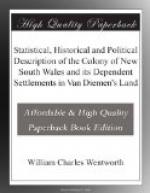From the foregoing statement is will be evident, that the future increase in the stock will be still more prodigious, and still more considerably outstrip the advance of population. The price therefore of cattle, great and rapid as has been its past declension, must annually experience a still further diminution. Of what will be their probable value in ten years more, it may enable us to form no very inaccurate estimate, by referring to what it was ten years back. In 1808, a cow and calf were sold by public auction for L105, and the price of middling cattle was from L80 to L100. A breeding mare was at the same period worth from 150 to 200 guineas, and ewes from L10 to L20.
These immense prices, however, were the result of monopoly, and consequently in a great measure fictitious; for in 1810, two years after this, a herd of fine cattle were sold for L13 per head. This almost incredible reduction in the value of cattle in so short a period, was occasioned by the supercession of this monopoly by the governor, who in the year 1808, was induced, from the considerable increase that had taken place in the public herds, to issue cows at L28 per head, payable in agricultural produce, to all indiscriminately who chose to purchase them. Hundreds of them, therefore, at this epoch, were distributed among the settlers, and their extreme value insured that degree of care and attention from their owners, which was naturally followed by a rapid increase, and produced in the short lapse of two years, that declension of price which would at first sight appear so astonishing.
Thus it may be perceived, that within the last ten years, stock of all sorts have decreased in price, from L700 to L1,000 per cent. and it is not unreasonable to conclude, that in ten years hence, they will have experienced at least a similar reduction. Should this conjecture be verified, they will be of as little value in the remote parts of the colony, as the horses and cattle on the plains of Buenos Ayres, where any person may make what use he pleases of the carcase, provided he leaves behind him the hide.
Price of labour.




